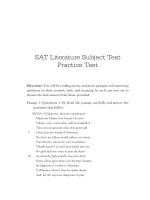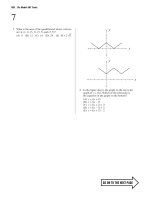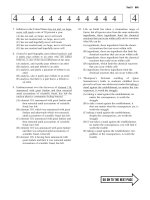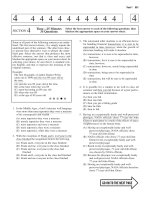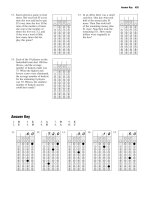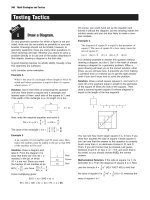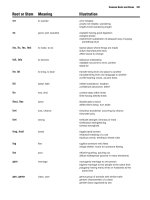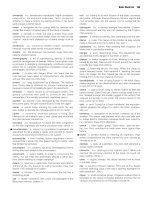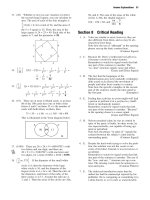Barron’s SAT subject test chemistry 11th 2014
Bạn đang xem bản rút gọn của tài liệu. Xem và tải ngay bản đầy đủ của tài liệu tại đây (14.77 MB, 1,268 trang )
Dedicated
to
mywife,Jean,anddaughters,Lisa,Linda,andLori,andtheirfamilies,
whosupportedmyeffortsthroughouttheyears
AbouttheAuthor:
Joe Mascetta has taught high school chemistry for twenty years. He was the
science department coordinator and principal of Mt. Lebanon High School in
Pittsburgh, Pennsylvania. He also served as a science consultant to the area
schools and is a past-president of the Western Pennsylvania Association of
Supervision and Curriculum Development (ASCD) and the State Advisory
Committee of ASCD. He holds degrees from the University of Pittsburgh, the
University of Pennsylvania, and Harvard University, and was a participant in
Harvard Project Physics, a General Electric Science Fellowship to Union
College in Schenectady, New York, the Chemical Bond Approach Curriculum
Study at Kenyon College, Ohio, and the Engineering Concepts Curriculum
ProjectandScienceCurriculumSupervisionattheUniversityofColorado.
©Copyright2010,2008,2006byBarron’sEducationalSeries,Inc.
Prioreditions©Copyright2002,1998,1994byBarron’sEducationalSeries,Inc.,
underthetitleHowtoPreparefortheSATII:Chemistry.
Prioreditions©Copyright1990,1986,1981,1969byBarron’s
EducationalSeries,Inc.,
underthetitleHowtoPrepareforCollegeBoardAchievementTestinChemistry.
Allrightsreserved.
Nopartofthisworkmaybereproducedordistributedinanyformorbyanymeanswithoutthewritten
permissionofthecopyrightowner.
Allinquiriesshouldbeaddressedto:
Barron’sEducationalSeries,Inc.
250WirelessBoulevard
Hauppauge,NewYork11788
www.barronseduc.com
eISBN:978-1-4380-8374-2
Revisede-Pubpublication:August,2012
Contents
Introduction:AbouttheTest
ADIAGNOSTICTEST
ADiagnosticTest
AnswersandExplanations
CalculatingYourScore
DiagnosingYourNeeds
PlanningYourStudy
FinalPreparation—TheDayBeforetheTest
AftertheTest
REVIEWOFMAJORTOPICS
1IntroductiontoChemistry
Matter
Energy
ConservationofMassandEnergy
ScientificMethod
MeasurementsandCalculations
ChapterSummary
InternetResources
PracticeExercises
2AtomicStructureandthePeriodicTableoftheElements
ElectricNatureofAtoms
AtomicSpectra
TheWave-MechanicalModel
SublevelsandElectronConfiguration
TransitionElements
PeriodicTableoftheElements
PropertiesRelatedtothePeriodicTable
NuclearTransformationsandStability
TheNatureofRadioactiveEmissions
MethodsofDetectionofAlpha,Beta,andGammaRays
DecaySeries,Transmutations,andHalf-life
RadioactiveDating
NuclearReactions
ChapterSummary
InternetResources
PracticeExercises
3Bonding
TypesofBonds
IntermolecularForcesofAttraction
DoubleandTripleBonds
ResonanceStructures
MolecularGeometry—VSEPR—andHybridization
SigmaandPiBonds
PropertiesofIonicSubstances
PropertiesofMolecularCrystalsandLiquids
ChapterSummary
InternetResources
PracticeExercises
4ChemicalFormulas
NamingandWritingChemicalFormulas
OxidationStatesandFormulaWriting
NamesandFormulasofCommonAcidsandBases
ChemicalFormulas:TheirMeaningandUse
LawsofDefiniteCompositionandMultipleProportions
WritingandBalancingSimpleEquations
ShowingPhasesinChemicalEquations
WritingIonicEquations
ChapterSummary
InternetResources
PracticeExercises
5GasesandtheGasLaws
SomeRepresentativeGases
GeneralCharacteristicsofGases
GasLawsandRelatedProblems
ChapterSummary
InternetResources
PracticeExercises
6Stoichiometry(ChemicalCalculations)andtheMoleConcept
TheMoleConcept
MolarMassandMoles
MoleRelationships
GasVolumesandMolarMass
DensityandMolarMass
Mass–VolumeRelationships
Mass–MassProblems
Volume–VolumeProblems
ProblemswithanExcessofOneReactantoraLimitingReactant
PercentYieldofaProduct
ChapterSummary
InternetResources
PracticeExercises
7Liquids,Solids,andPhaseChanges
Liquids
PhaseEquilibrium
BoilingPoint
CriticalTemperatureandPressure
Solids
PhaseDiagrams
Water
PolarityandHydrogenBonding
Solubility
WaterSolutions
ContinuumofWaterMixtures
ExpressionsofConcentration
Dilution
ColligativePropertiesofSolutions
Crystallization
ChapterSummary
InternetResources
PracticeExercises
8ChemicalReactionsandThermochemistry
PredictingReactions
Thermochemistry
ChangesinEnthalpy
AdditivityofReactionHeatsandHess’sLaw
ChapterSummary
InternetResources
PracticeExercises
9RatesofChemicalReactions
FactorsAffectingReactionRates
ActivationEnergy
ReactionRateLaw
ChapterSummary
InternetResources
PracticeExercises
10ChemicalEquilibrium
ReversibleReactionsandEquilibrium
LeChâtelier’sPrinciple
EffectsofChangingConditions
EquilibriainHeterogeneousSystems
CommonIonEffect
DrivingForcesofReactions
ChapterSummary
InternetResources
PracticeExercises
11Acids,Bases,andSalts
DefinitionsandProperties
Indicators
Titration—VolumetricAnalysis
BufferSolutions
Salts
AmphotericSubstances
AcidRain—AnEnvironmentalConcern
ChapterSummary
InternetResources
PracticeExercises
12Oxidation-ReductionandElectrochemistry
Oxidation-ReductionandElectrochemistry
QuantitativeAspectsofElectrolysis
BalancingRedoxEquations
ChapterSummary
InternetResources
PracticeExercises
13SomeRepresentativeGroupsandFamilies
SulfurFamily
HalogenFamily
NitrogenFamily
Metals
ChapterSummary
InternetResources
PracticeExercises
14CarbonandOrganicChemistry
Carbon
OrganicChemistry
Hydrocarbons
HydrocarbonDerivatives
ChapterSummary
InternetResources
PracticeExercises
15TheLaboratory
LaboratorySafetyRules
SomeBasicSetups
SummaryofQualitativeTests
ChapterSummary
InternetResources
PracticeExercises
PRACTICETESTS
PracticeSubjectTestsinChemistry
PracticeTest1
AnswersandExplanationsforTest1
CalculatingYourScore
DiagnosingYourNeeds
PracticeTest2
AnswersandExplanationsforTest2
CalculatingYourScore
DiagnosingYourNeeds
PracticeTest3
AnswersandExplanationsforTest3
CalculatingYourScore
DiagnosingYourNeeds
PracticeTest4
AnswersandExplanationsforTest4
CalculatingYourScore
DiagnosingYourNeeds
APPENDIXES
ModernPeriodicTable
SomeImportantEquations
SomeUsefulTables
TheChemicalElements
Glossary
Introduction:AbouttheTest
The SAT Subject Tests are given in specific subject areas to assess your
academicabilitiesforcollege.TheyarepreparedbytheCollegeBoardandgive
evidence about your readiness in specific academic areas. The test can
complement and enhance your college admission credentials. The introduction
ofthisbookwillgiveyouallthebasicinformationyouneedtoknowaboutthe
subject test in chemistry. To learn additional information about this testing
program, go tothe websitewww.collegeboard.organdlookunderSATSubject
Tests
AlloftheSATSubjectTestsarecontainedinthesametestbooklet.Eachtakes
1houroftestingtime,andyoumaychooseanyone,two,orthreeteststotakeat
onesitting.
ManycollegesrequireorrecommendoneormoreSubjectTestsforadmission
orplacement.Thescoresareusedinconjunctionwithyourhighschoolrecord,
resultsontheSAT,teacherrecommendations,andotherbackgroundinformation
to provide a reliable measure of your academic achievements and a good
predicationofyourfutureperformance.
Inadditiontoobtainingastandardizedassessmentofyourachievementfrom
yourscores,somecollegesusethetestresultsforplacementintotheirparticular
programs in the freshman year. At others, advisers use the results to guide
freshmenintheselectionofcourses.
IstheSATSubjectTestinChemistryRequired?
The best information on whether SAT Subject Tests are required and, if so,
whichonesisfoundintheindividualcollegecatalogsoradirectoryofcolleges.
Some colleges specify which tests you must take, while others allow you to
choose. Obviously, if you have a choice and you have done well in chemistry,
youshouldpicktheSATSubjectTestinChemistryasoneofyourtests.Evenif
thetestisnotrequiredbythecollegestowhichyouareapplying,youcanadd
theresulttoyourrecordtosupportyourachievementlevel.
WhenShouldYouTaketheTest?
You will undoubtedly do best if you take the test after completing the high
school chemistry course or courses that you plan to take. At this time, the
materialwillbefreshinyourmind.Forgettingbeginsveryquicklyafteryouare
pastatopicorhavefinishedthecourse.Youshouldplanareviewprogramforat
leastthelast6weeksbeforethetestdate.(Aplanisprovidedlaterinthisbook
forsuchareview.)Carefulreviewdefinitelyhelps—crammingjustwillnotdoif
youwanttogetthebestscoreofwhichyouarecapable!
Colleges that use SAT Subject Test results as part of the admissions process
usuallyrequirethatyoutakethetestnolaterthanDecemberorJanuaryofyour
senior year. For early-decision programs, the test time is June of your junior
year. Since chemistry is often a junior year course, June of that year is the
optimumtimetotakethetest.
WhenIstheTestOffered?
ThechemistrytestisavailableeverytimetheSATSubjectTestsaregiven,that
is,onthefirstSaturdayofOctober,November,December,May,andJune.They
are also given on the last Saturday of January. Be sure that the testing site for
which you plan to register offers the SAT Subject Tests on each of these six
times.Rememberthatyoumaychoosetotakeoneortwoadditionaltestsbesides
chemistry on any one test day. You do have to specify in advance which tests
youplan to takeon thetestdateyou select;however, except forthe Language
TestwithListening,youmaychangeyourmindonthedayofthetest.
HowDoYouRegister?
You may get all of your registration information by going to
sat.collegeboard.org/register/how to register. This is the quickest and easiest
waytoregisterforthetest.Thissitewillgiveyoualltheinformationyouneed
tocompleteyourregistration.Youcanchooseyourtestdateandcenteraswell
as receive immediate registration confirmation. This website also gives you
instructionsforhowtoregisterbymail.
Thedeadlineforregistrationisapproximatelyonemonthbeforethetestdate.
HowShouldYouPreparefortheTest?
Barron’sSATSubjectTestinChemistrywillbeveryhelpful.Themoreyouknow
aboutthetest,themorelikelyyouaretogetthebestscorepossibleforyou.This
bookprovidesyouwithadiagnostictest,scoringinformation,fourpracticetests
and the equivalent of one more test incorporated with the chapter review tests
that allow you to become familiar with the question types and the wording of
directions,andtogainafeelforthedegreeofemphasisonparticulartopicsand
the ways in which information may be tested. Each of these aspects should be
consciouslypursuedasyouusethisbook.
WhatTopicsAppearontheTest,andtoWhatExtent?
Thefollowingchartsshowthecontentofthetestandthelevelsofthinkingskills
tested:
Note:Eachtestcontainsapproximatelyfivequestionsonequationbalancingand/orpredictingproductsof
chemicalreactions.Thesearedistributedamongthevariouscontentcategories.
The first chart gives you a general overview of the content of the test. Your
knowledgeofthetopicsandyourskillsinrecalling,applying,andsynthesizing
this knowledge are evaluated through 85 multiple-choice questions. This
material is that generally covered in an introductory course in chemistry at a
level suitable for college preparation. While every test covers the topics listed,
different aspects of each topic are stressed from year to year. Add to this the
differences that exist in high school courses with respect to the percentage of
timedevotedtoeachmajortopicandtothespecificsubtopicscovered,andyou
may find that there are questions on topics with which you have little or no
familiarity.
Each of the sample tests in this book is constructed to match closely the
distributionoftopicsshownintheprecedingchartsothatyouwillgainafeelfor
the makeup of the actual test. After each test, a chart will show you which
questionsrelatetoeachtopic.Thiswillbeveryhelpfultoyouinplanningyour
reviewbecauseyoucanidentifytheareasonwhichyouneedtoconcentratein
yourstudies.Anotherchartenablesyoutoseewhichchapterscorrespondtothe
varioustopicareas.
WhatGeneralInformationShouldYouHaveAbout
theTest?
1.Aperiodicchartisprovidedinthistestasaresourceandasthesourceof
atomicnumbersandatomicmassesoftheelements.
2.Youwillnotbeallowedtouseanelectroniccalculatorduringthetest.
3.Mathematicalcalculationsarelimitedtosimplealgebraicandnumerical
ones.
4.Youshouldbefamiliarwiththeconceptsofratiosandofdirectandinverse
proportions,scientificnotation,andexponentialfunctions.
5.Metricsystemunitsareusedinthistest.
6.Thetestiscomposedofthreetypesofquestionsasexplainedinthenext
section.
WhatTypesofQuestionsAppearontheTest?
TherearethreegeneraltypesofquestionsontheSATSubjectTestinChemistry
— matching questions, true/false and relationship analysis questions, and
general five choice questions. This section will discuss each type and give
specific examples of how to answer these questions. You should learn the
directionsfor eachtypesothatyouwillbefamiliarwiththemonthetestday.
Thedirectionsinthissectionaresimilartothoseonthetest.
TYPE1.MATCHINGQUESTIONSINPARTA.Ineachofthesequestions,
youaregivenfiveletteredchoicesthatyouwillusetoanswerallthequestions
in that set. The choices may be in the form of statements, pictures, graphs,
experimental findings, equations, or specific situations. Answering a question
may be as simple as recalling information or as difficult as analyzing the
informationgiventoestablishwhatyouneedtodoqualitativelyorquantitatively
to synthesize your answer. The directions for this type of question specifically
statethatachoicemaybeusedonce,morethanonce,ornotatallineachset.
PartA
Directions: Every set of the given choices below refers to the numbered
statements or formulas immediately following it. Choose the one lettered
choice that best fits each statement or formula and then fill in the
corresponding oval on the answer sheet. Each choice may be used once,
morethanonce,ornotatallineachset.
EXAMPLE
Questions1–3refertothefollowinggraphs:
1.Thegraphthatbestshowstherelationshipofvolumetotemperaturefor
anidealgaswhilethepressureisheldconstant
2.Thegraphthatbestshowstherelationshipofvolumetopressureforan
idealgaswhilethetemperatureisheldconstant
3.Thegraphthatbestshowstherelationshipofthenumberofgramsof
solutethatissolublein100gramsofwateratvaryingtemperaturesifthe
solubilitybeginsasasmallquantityandincreasesslowlyasthe
temperatureisincreased
These three questions require you to recall the basic gas laws and the graphic
depictionoftherelationshipexpressedineachlaw,aswellashowsolubilitycan
beshowngraphically.
Toanswerquestion1,youmustrecognizethattherelationshipofgasvolume
to changes in temperature is a direct relationship that is depicted by graphing
Charles’s Law: V1/T1 = V2/T2. The only graph that shows that type of direct
relationshipwiththeappropriateslopeis(A).
Toanswerquestion2,youneedtounderstandthatBoyle’sLawstatesthatthe
pressureofagasisinverselyproportionaltothevolumeatconstanttemperature.
Mathematically,thismeansthatpressure(P)timesvolume(V)isaconstant,or
P1V1= P2V2. This inversely proportional relationship is accurately depicted in
(C).Although(B)showsthevaluesonthex-axisincreasingasthey-axisvalues
decrease,itdoesnotfitthegraphforaninverseproportion.
Question3requiresthatyouhaveknowledgeaboutsolubilitycurvesandcan
applythesolubilityrelationshipgiveninwordstograph(E).
TYPE2.TRUE/FALSEANDRELATIONSHIPQUESTIONSINPARTB.
On the actual SAT Subject Test in Chemistry, this type of question must be
answeredinaspecialsectionofyouranswersheetlabeled“chemistry.”Type2
questions are numbered beginning with 101. Each question consists of a
statementorassertionincolumnIand,ontheothersideofthewordBECAUSE,
another statement or assertion in column II. Your first task is to determine
whethereachofthestatementsistrueorfalseandtorecordyouranswerforeach
intheanswerblocksforcolumnIandcolumnIIintheanswergridbydarkening
eitherthe orthe oval. Here you must use your reasoning skills and your
understanding of the topic to determine whether there is a cause-and-effect
relationshipbetweenthetwostatements.
Herearethedirectionsandtwoexamplesofarelationshipanalysisquestion.
PartB
Directions: Every question below contains two statements, I in the lefthandcolumnandIIintheright-handcolumn.Foreachquestion,decideif
statementIistrueorfalseandifstatementIIistrueorfalseandfillinthe
corresponding T or F ovals on your answer sheet. Fill in oval CE only if
statementIIisacorrectexplanationofstatementI.
SampleAnswerGrid:
CHEMISTRY*FillinovalCEonlyifIIisacorrectexplanationofI.
EXAMPLE1
101. When 2 liters of oxygen
gasreactcompletelywith2
liters of hydrogen gas, the
limiting factor is the
volumeoftheoxygen
BECAUSE
thecoefficientsinthe
balancedequationofa
gaseousreactiongive
thevolume
relationshipofthe
reactinggases.
Thereactionthattakesplaceis
2H2+O2→2H2O
Thecoefficientsofthisgaseousreactionshowthat2Lofhydrogenreactwith1
Lofoxygen,leaving1Lofunreactedoxygen.Thelimitingfactoristhequantity
ofhydrogen.
TheabilitytosolvethisquantitativerelationshipshowsthatstatementIisnot
true. However, statement II does give a true statement of the relationship of
coefficientsinabalancedequationofgaseouschemicalreaction.Therefore,the
answerblockswouldbecompletedlikethis:
EXAMPLE2
102. Water is a good solvent of
ionicandpolarcompounds
BECAUSE
thewatermolecule
haspolarproperties
duetothefactors
involvedinthe
bondingofthe
hydrogenandoxygen
atoms.
Statement I is true because water is such a good solvent that, as you have
probably learned, it is sometimes referred to as the universal solvent. This
property is attributed mostly to its polar structure. The polar covalent bond
between the oxygen and hydrogen atoms and the angular orientation of the
hydrogens at 105 degrees between them contribute to the establishment of a
permanentdipolemomentinthewatermolecule.Thisalsogivesrisetoahigh
degree of hydrogen bonding. These properties combine to make water a
powerful solvent for both polar and ionic compounds. Because of your
familiarity with these concepts and the processes by which substances go into
solution,youknowthatstatementIInotonlyistruebutalsoisthereasonthat
statement I is true. There is a cause-and-effect relationship between the two
statements.Therefore,theanswerblockswouldbemarkedlikethis:
TYPE 3: GENERAL FIVE-CHOICE QUESTIONS IN PART C. The fivechoice items in Part C are written usually as questions but sometimes as
incomplete statements. You are given five suggested answers or completions.
Youmustselecttheonethatisbestineachcaseandrecordyourchoiceinthe
appropriateoval.Insomequestionsyouareaskedtoselecttheoneinappropriate
answer.Suchquestionscontainawordincapitalletters,suchasNOT,LEAST,
orEXCEPT.
Insomeofthesequestions,youmaybeaskedtomakeanassociationbetween
a graphic, pictorial, or mathematical representation and a stated explanation or
problem. The solution may involve solving a scientific problem by correctly
interpreting the representation. In some cases the same representation may be
used for a series of two or more questions. In no case, however, is the correct
answertoonequestionnecessaryforansweringasubsequentquestioncorrectly.
Eachquestioninthesetisindependentoftheothers.
PartC
Directions: Everyquestion orincompletestatementbelowisfollowedby
fivesuggestedanswersorcompletions.Choosetheonethatisbestineach
caseandthenfillinthecorrespondingovalontheanswersheet.Remember
toreturntotheoriginalpartoftheanswersheet.
EXAMPLE1
40.Inthisgraphicrepresentationofachemicalreaction,whicharrow
depictstheactivationenergy?
(A)A
(B)B
(C)C
